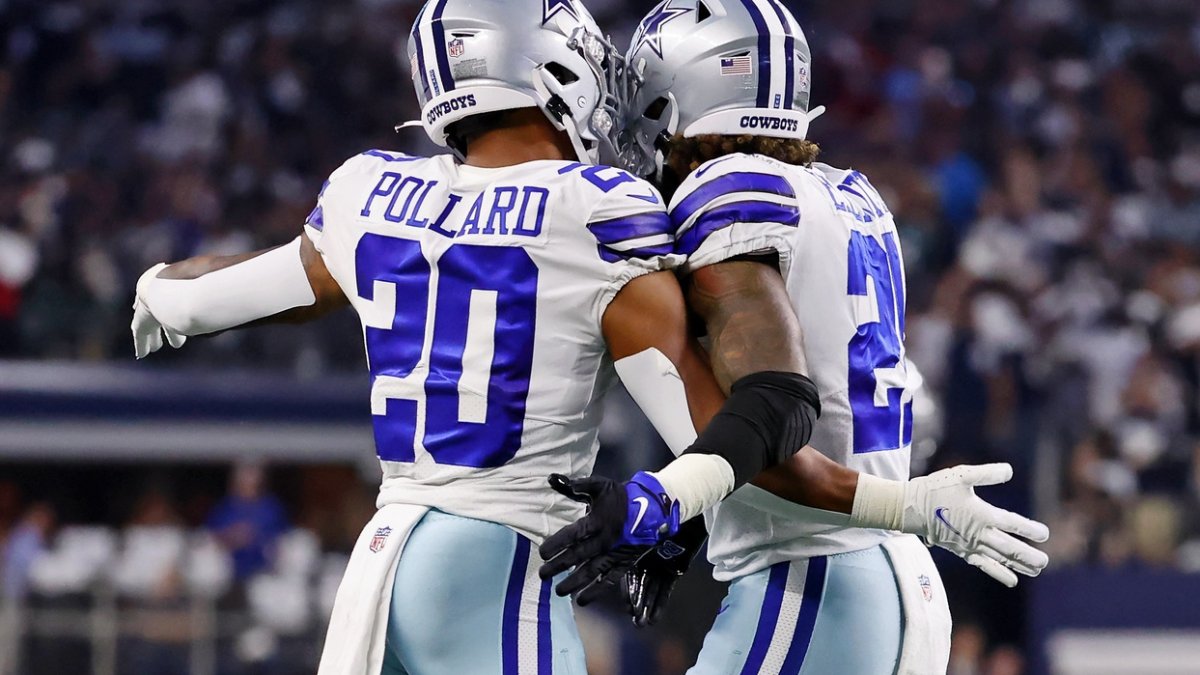Over the last couple of weeks, the longstanding debate about how Tony Pollard and Ezekiel Elliott should split time in the Dallas Cowboys backfield has intensified.
However, these debates might overshadow how good the two have been and make people forget to appreciate how well the two complement one another. After all, Dallas is one of only six teams with two running backs who rank in the top 20 in PFF grade.
Highest-graded running backs (min. 200 snaps)
| Rank | Name | Team | Snaps | PFF Grade |
| 1 | Josh Jacobs | Raiders | 630 | 92.7 |
| 2 | Nick Chubb | Browns | 452 | 90.5 |
| 3 | Aaron Jones | Packers | 507 | 87.8 |
| 4 | Tony Pollard | Cowboys | 418 | 86.8 |
| 5 | Brian Robinson Jr. | Commanders | 259 | 86.4 |
| 6 | Christian McCaffrey | 49ers | 550 | 85.9 |
| 7 | Rhamondre Stevenson | Patriots | 524 | 85.2 |
| 8 | Derrick Henry | Titans | 452 | 84.2 |
| 9 | Dameon Pierce | Texans | 471 | 81.3 |
| 10 | Cordarrelle Patterson | Falcons | 269 | 80.2 |
| 11 | Antonio Gibson | Commanders | 429 | 78.2 |
| 12 | Latavius Murray | Broncos | 253 | 77.6 |
| 13 | Miles Sanders | Eagles | 497 | 77.6 |
| 14 | A.J. Dillon | Packers | 413 | 77.3 |
| 15 | Tyler Allgeier | Falcons | 338 | 76.4 |
| 16 | Austin Ekeler | Chargers | 536 | 76.3 |
| 17 | Joe Mixon | Bengals | 457 | 76.2 |
| 18 | Samaje Perine | Bengals | 330 | 76.0 |
| 19 | Ezekiel Elliott | Cowboys | 366 | 75.7 |
| 20 | D'Onta Foreman | Panthers | 235 | 75.5 |
Pollard has been on the field more than Elliott this year, mainly because of the knee injury that sidelined Elliott for two games. But even though Pollard has out-snapped Elliott 418 to 366, the former Ohio State Buckeye has nine more carries on the year. Pollard has played 22 more receiving snaps and seen 20 more targets.
Pollard superior in the passing game
During his time in the league, Elliott has developed a reputation for being a strong pass-blocker. But Pollard took a huge step forward in this area in 2022, which has allowed him to play more third-down snaps.
Pass protection used to be a weakness of Pollard’s game. He failed to earn a pass-blocking grade above 55.0 in each of his first three seasons, and he allowed his quarterback to get sacked or hit on 8.9% of his snaps over that entire period, 80th among 81 qualifying running backs.
However, his 74.4 pass-blocking grade currently ranks ninth out of 62 running backs. And with five weeks left, he has already set a career-high in pass-blocking snaps played. The former Memphis Tiger has also fared better as a pass-patcher, as his 68.6 receiving grade betters Elliott's 41.8 and ranks 14th among qualifying running backs.
While Elliott has dropped two of his 13 catchable targets, Pollard has just one drop on 27. Furthermore, Pollard has picked up a first down or touchdown on 11 of his 26 receptions, compared to Elliott’s two first downs on 11.
As a result, Pollard averages more than twice as many yards per reception and 1.1 yards more per route run.
The better runner?
Pollard is a big play waiting to happen on runs, as well. He is tied with New York Giants star Saquon Barkley for the second-most runs of 15 or more yards, while Elliott has just six. He has gained 47.1% of his rushing yards on such explosive runs, fourth in the league, while Elliott ranks 39th in the NFL in this category at 18.3%.
All these categories and figures support Pollard getting a bigger role in the Cowboys offense, but Elliott should not be an afterthought, as his skills perfectly complement Pollard's.
The former No. 4 overall pick has scored a touchdown on seven of his 11 goal-to-go carries for a 63.6% success rate that ranks third among 48 running backs with at least five such attempts.
Elliott has also been used a lot in short-yardage situations. In fact, he leads the league in carries on third and fourth downs when the offense needs just one or two yards. On 20 such carries, he picked up 16 first downs (or touchdowns) for a success rate of 80%, ninth-best in the NFL and 13.3 points ahead of Pollard's number.
Lately, the Dallas offense has been firing on all cylinders, and it is largely thanks to the performance of their two running backs. While it is fun to argue about which one is more important and who should play more, this should not come at the cost of appreciating how well they perform as a unit and how differently they can be used.




 © 2025 PFF - all rights reserved.
© 2025 PFF - all rights reserved.